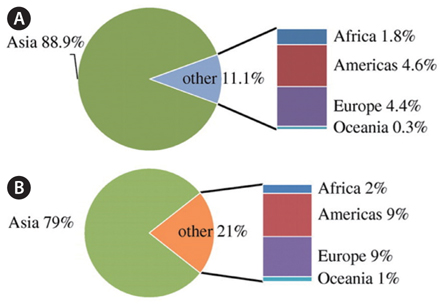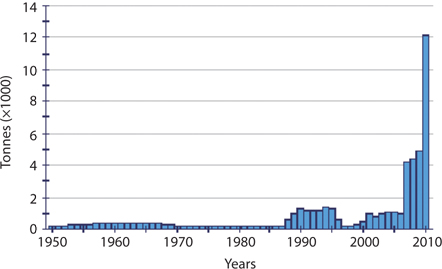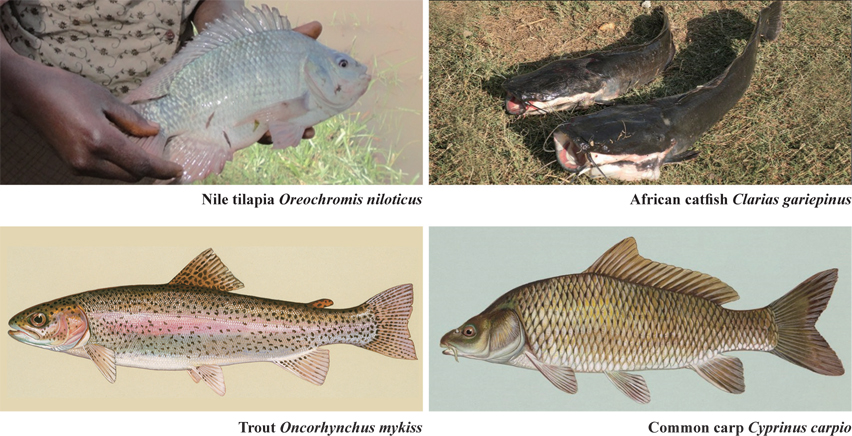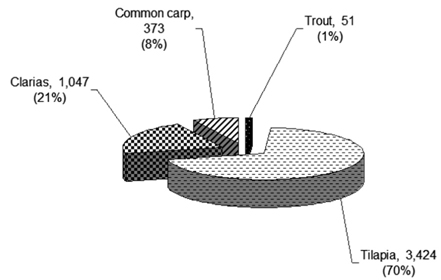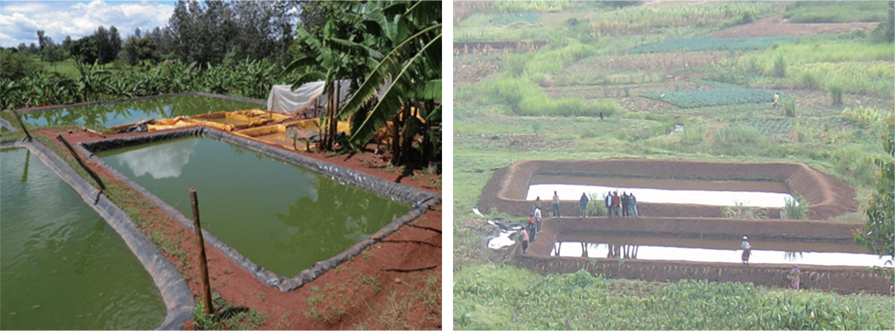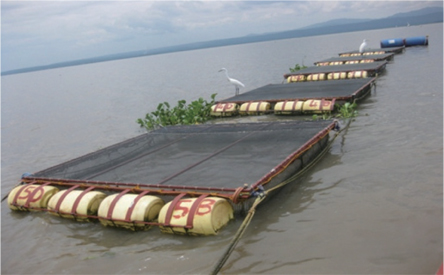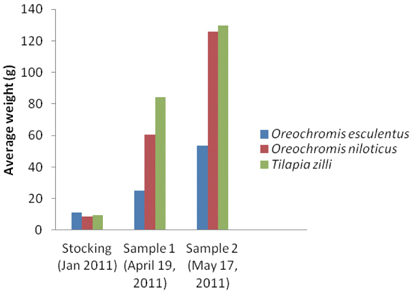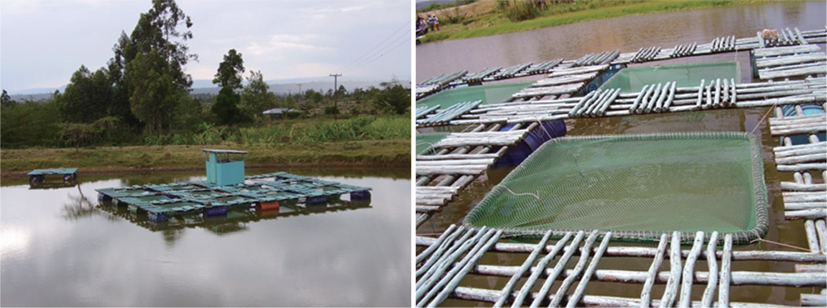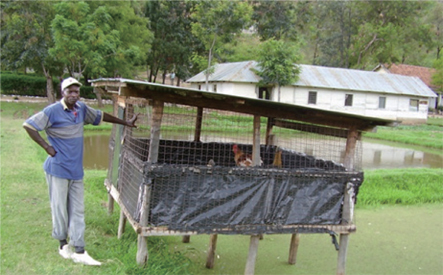



Growth of the global aquaculture industry has been sporadic over the last 50 years, and the global production capabilities of culture and capture fisheries are almost comparable (Food and Agriculture Organization of the United Nations, 2012). The sporadic growth has been largely attributable to technological advancements in fish production,
Fish farming was first begun in Kenya by colonists in the early 1900s through introduction of trout in rivers for sport fishing (Ngugi et al., 2007). This progressed into static pond culture of species such as tilapia, common carp, and catfish in the 1920s (Maar et al., 1966). Indeed, the establishment of Sagana and Kiganjo fish farms for production of warm- and cold-water seed fish in 1948 was the beginning of small-scale rural fish farming in Kenya, which became popular in the 1960s (Ngugi and Manyala, 2004; Nyonje et al., 2011). Furthermore, “eat more fish campaigns” promoted by the government in the late 1960s also accelerated the interest in rural fish farming (Ngugi and Manyala, 2004; Ngugi et al., 2007). The primary cultured fish species in Kenya today are Nile tilapia (75%) and African catfish (15%) (Ngugi and Manyala, 2004), but efforts to introduce other indigenous fish, such as
Current Status of Kenyan Aquaculture
Kenya is endowed with several inland natural water resources such as Lakes Victoria, Turkana, Baringo, Naivasha, Chala, Kanyaboli, and Jipe, among others. Major rivers include the Tana, Athi, Nyando, Nzoia, Gucha, Migori, Yala, and Mara. In addition to artificial water bodies from dams, which are spread across the landscape, Kenya boasts approximately 600 km of coastal shoreline with an Exclusive Economic Zone of 200 nautical miles, which could be harnessed to enhance aquaculture. Although most parts of the country are suitable for aquaculture, only about 0.014% of the 1.4 million ha of potential aquaculture sites are used for aquaculture and about 95% of fish farming is on a small scale (Otieno, 2011). In addition, fish farming has been practiced mostly in the central, Nyanza, western provinces, and parts of Rift Valley and coastal provinces (Nyonje et al., 2011).
Since the beginning of Kenyan aquaculture in the 1950s until 2006, total annual aquaculture production has never exceeded 2,000 MT/y (Fig. 2). Prior to the government-funded Economic Stimulus Program (ESP), about 7,500 fish farmers, mostly from the Rift Valley and central provinces, held about 7,477 production units in an estimated area of 722.4 ha (Nyonje et al., 2011). By 2007, the mean yield from fish farming was approximately 5.84 MT yr–1, compared to 4,452 MT of the total annual fish production, and was valued at $10.78 million, accounting for only 3% of the total fish production (National Economic Survey, 2006). Recognizing aquaculture as one of the viable options for revamping the country’s food sector, the Kenyan government initiated the ambitious ESP in 2009 to stimulate economic development, foster economic recovery, alleviate poverty, and spur regional development (Nyonje et al., 2011). The Fish Farming Enterprise Productivity Program under the ESP was aimed at injecting commercial thinking into fish farming to build up a vibrant aquaculture industry. The program aimed to increase production of farmed fish from 4,000 MT to over 20,000 MT in the medium term and to more than 100,000 MT in the long term (Charo-Karisa and Gichuri, 2010). In the first year of the program, 200 fish ponds were constructed in each of 140 constituencies, totaling more than 27,000 fish ponds nationally (Charo-Karisa and Gichuri, 2010); Musa et al., 2012). This triggered an immediate shortterm demand for about 28 million certified tilapia and catfish fingerlings and over 14,000 MT of formulated fish feeds, which could not be adequately and timely supplied, even by the private sector (Musa et al., 2012). The ripple effect of the ESP led some farmers to dig their own ponds, further increasing the demand for seed fish and feed to over 100 million and 100,000 MT, respectively (Charo-Karisa and Gichuri, 2010); Musa et al., 2012). Apart from the effects of the ESP, most people who abandoned subsistence farming for fish farming, and new farmers practicing commercial aquaculture, now own bigger ponds, resulting in higher yields (Otieno, 2011). Indeed, current national aquaculture production, including harvests from the ESP and other private farms, is estimated at 12,000 MT/y (Fig. 2), equivalent to 7% of the total production and valued at $21 million (Nyonje et al., 2011). Production is projected to hit 20,000 MT/y, representing 10% of national fish production, in the next 5 years (Nyonje et al., 2011). This presents a lucrative opportunity for aquaculture development in the feed and seed fish sectors, which unfortunately still suffer from basic problems.
To date, the Kenyan government has designated several aquaculture facilities in various parts of the country to serve as research centers, training facilities, and sources of fingerlings and feed for fish farmers. They include the National Aquaculture Research Development & Training Center (NARDTC) in Sagana, Kisii fish farm training center, Kiganjo trout farm, Ndaragua trout farm, Chwele fish farm, Lake Basin Development Authority (LBDA) in Kisumu, Wakhungu fish farm in Busia, Sangoro research station, Kegati research station, and Kabonyo and Ngomeni fish farms. However, most of these centers lack basic laboratory equipment and human capacities to spur significant aquaculture development in their respective spheres of influence.
Productivity of Aquaculture Systems in Kenya
Like in other African countries, fish farming in Kenya has been extensive but less intensive (Ngugi et al., 2007). Intensive fish farming is unpopular due to the high cost of infrastructure advancements and the knowledge needed. However, some farmers on the outskirts of major towns and cities are becoming more receptive up to recirculating aquaculture systems, technologies that can help tap into the lucrative fish market in cities. The motivation for this is due to high production capacities within a small area, since land around the cities is expensive. The fish farmer’s decision of the optimal culture method is influenced largely by environmental, economic, and managerial challenges that pose problems for many fish farmers (De Graaf et al., 2005). Table 1 shows the current number of fish culture systems in Kenya as a result of the effects of ESP and its ripple effects. The absence of data from other systems, such as cages, recirculating systems, and raceways, is a clear indication that the Kenyan aquaculture sector has room for expansion. Indeed, these are some of the areas that could be lucrative not only to local investors but also foreign investors.

The Kenya national distribution of fish culture systems and the respective cover area (m2) 2009
As late as 2011, about 5,000 tons of various farmed fish species (Fig. 3) valued at $12.3 million were harvested (Otieno, 2011). As usual, tilapia
Fish Culture in Earthen and Lined Ponds
Fish farming in earthen ponds has been advocated for the development of cheap food resources in developing nations (Food and Agriculture Organization of the United Nations, 2000). Over 90% of cultured fish in Sub-Saharan Africa come from earthen ponds of between 200 and 500 m2 (Ngugi et al., 2007; Mucai et al., 2011), where fish are fed primarily with locally available low cost agricultural by-products. This method of fish culture is popular in Kenya due to the low cost of establishment and generally good soil in most places,
In cases of land and water scarcity but favorable economic conditions, tank farming is a good alternative to ponds or cages. Tests have shown that fish can be grown at high densities in the confinement of tanks under quality management (Rakocy, 1989). During the production cycle, high fry stocking density is reduced at regular intervals to minimize crowding and ensure good water quality. Tank fish farming in Kenya is limited. In fact, we could find no literature to confirm the existence of fish tank farming in Kenya, which could be due to operational limitations, but it provides an unexploited opportunity for investment.
Fish farming in cages is done in existing water bodies (ponds, rivers, lakes, dams, and oceans). The fish are enclosed in a cage that allows free water exchange. Only strong, durable, and nontoxic materials are used to construct the cages, which vary in size and shape. The location of the cage in the water body may be critical for proper water circulation. Although little information is available on cage culture in Kenya, it may be an overlooked asset in the aquaculture sector. As fish cage culture in Lake Victoria has begun relatively recently, productivity data are largely lacking. Over the last 3 years, the Kenya Marine and Fisheries Research Institute (KMFRI) initiated preliminary trials of tilapia cage culture off Dunga beach in Kisumu, where impressive growth of
The construction of dams was also encouraged under the ESP, not only to provide water but also to encourage communal fish farming activities. Fish farming in dams is not very popular in Kenya and thus not well documented. However, dams have been used to house cages for experimental and research activities, such as the recently completed regional BOMOSA (2009) project, a multidisciplinary research project funded by the European Union (Fig. 8). This is another area that has not been fully exploited in Kenyan aquaculture.
An integrated fish culture approach involves the connection of agricultural systems to fish farming in a design that allows waste from one system to be used as input in another system, conserving resources and boosting returns (Edwards, 1980; Chen, 1989; Ayinla, 2003; Shoko et al., 2011). Through its biophysical and socioeconomic benefits, integrated fish farming has immense potential to address income instability, nutritional insecurity, unemployment, and poverty of farmers, not only in Kenya, but across East Africa (Ogello et al., 2013). Integrated fish farming is inexpensive and profitable and is another overlooked asset for present and future aquaculture development in the East African region (Ogello et al., 2013).
In Kenya, integrated fish culture is still in nascent stages of development with demonstrational infrastructure present in state-owned institutions such as the LBDA in Kisumu and the KMFRI in Sagana and Sangoro (Fig. 9). Nevertheless, farmers have embraced the practice across the country where they use mainly chicken and cow manure for pond fertilization, and have recorded impressive performance in some areas (Ogello and Opiyo, 2011; Ogello et al., 2013). Studies on integrated fish culture on the Kenyan side of the Lake Victoria Basin reported that a 200 m2 fish pond of
Current Status of the Kenyan Fish Feed Industry
Fish feed is a key component in any fish-farming venture because fish nutrition accounts for 40-50% of the total variable production costs on the fish farm (Craig and Helfrich, 2002; Munguti and Charo-Karisa, 2011). One of the most pressing current challenges in Kenyan aquaculture is the lack of efficient and inexpensive farm-made feeds for different stages of fish development (Munguti et al., 2012). In reaction to the ESP project, the Kenyan fish feed sector experienced a shortage of 14,000 MT/y (Charo-Karisa and Gichuri, 2010). Since then, demand has increased tremendously to about 50,000 MT/y. Due to the increased demand for fish feed, unscrupulous dealers sometimes sell feed of compromised quality, prompting the government to initiate efforts to establish national standards for fish feed. The fish feed standards (Table 2) were a culmination of several meetings and negotiations between all aquaculture stakeholders: the KMFRI, the Ministry of Fisheries, commercial feed companies, fish farmers, and the Kenya Bureau of Standards (KBS).
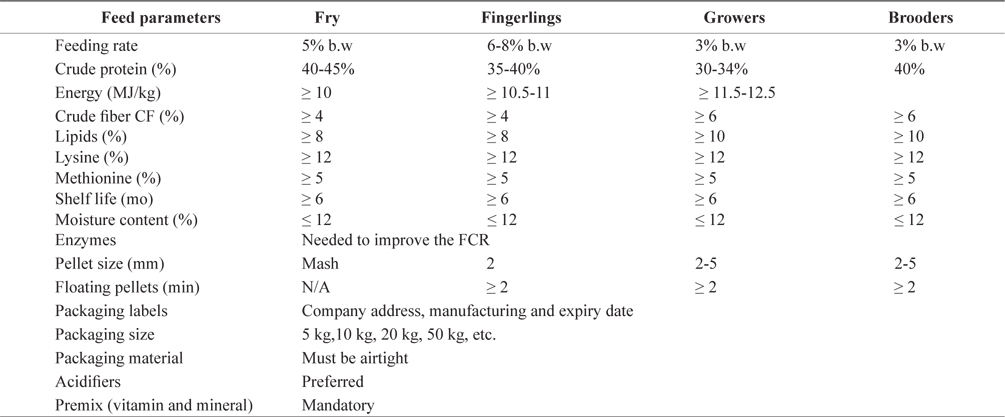
The Kenyan commercial fish feed standards for catfish and tilapia fry, fingerlings, growers and brooders
Most fish farmers in Kenya add manure or inorganic fertilizer to ponds because it increases the supply of natural food organisms. Commercial fish feeds for tilapia usually contain 24-28% crude protein (Liti et al., 2006) but are too expensive for most farmers. Therefore, most farmers prefer locally mixed feeds, such as a combination of 76% rice bran and 24% fish meal, which is a mix of dried freshwater shrimp
Due to the low quality of fish feeds in the Kenyan aquaculture market, the ESP nutrition team, together with other aquaculture stakeholders, established a vetting process for fish feed manufacturers. To date, 15 fish feed firms have been approved, but further survey efforts are under way to identify more firms (Table 3).
[Table 3.] Authenticated feed suppliers in Kenya
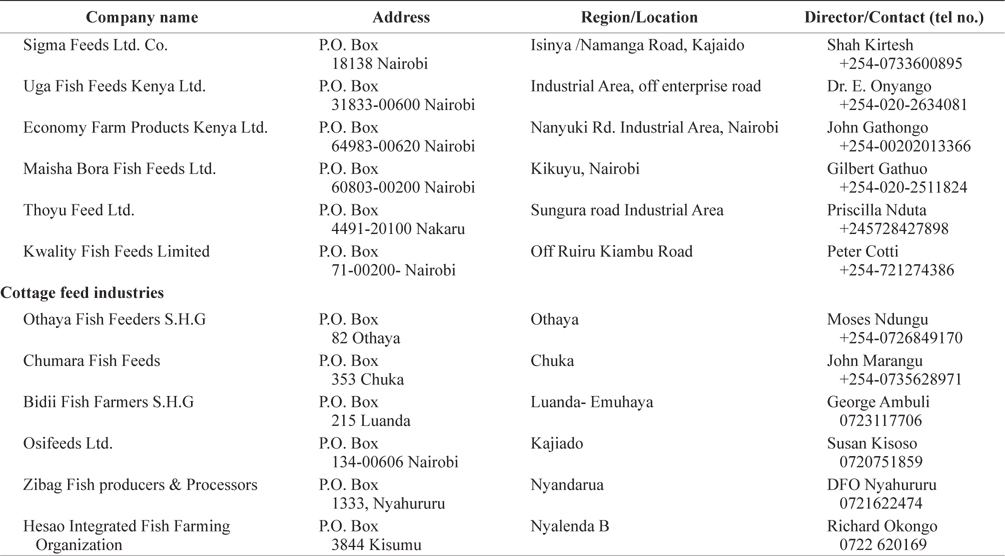
Authenticated feed suppliers in Kenya
Current Status of the Seed Fish Sector
Insufficient availability and quality of fingerlings for stocking are key constraints for the development of Kenyan aquaculture. In addition to the escalating demand for African catfish
Challenges in the Kenyan Aquaculture Sector
Unfortunately, after many years of fish farming in Kenya, the country is still suffering from basic challenges. The Kenyan aquaculture industry suffers from limited knowledge of aquaculture investment (Ngugi and Manyala, 2004) and lack of information on the economic performance of various fish farming systems (Kaliba et al., 2007). More importantly, the inadequate supply of certified quality feed and seed fish has been a longstanding hurdle to the growth of aquaculture. Farmers have given up fish farming because they run into huge losses after stocking their ponds with low-quality fingerlings and substandard feed. Other factors affecting the growth of aquaculture include lack of a comprehensive aquaculture policy, poor extension services, lack of robust needbased research coupled with low funding, lack of investment by the private sector, and unfocused promotion of aquaculture through many institutions (Gitonga et al., 2004). Indeed, improvements in fish culture systems, such as increasing pond productivity, introducing other efficient systems, and developing a sustainable mechanism for production and distribution of pond inputs, are challenges that still need to be addressed. With the explosive interest in fish farming stimulated by the ESP, new challenges from environmental pollution, biosecurity, and the spread of diseases are likely to emerge in the near future.
Opportunities for Present and Future Aquaculture Development
The major problem with marine fish larviculture is the lack of proper food that contains all the essential nutrients required by fish larvae, which has led to mass mortalities up to 100% (Sorgeloos, 1980). Recently, a great opportunity has presented itself on the Kenyan coast, thanks to the permanent establishment of a population of
Kenya has a relatively lengthy coastline endowed with a wide variety of habitats for seaweed communities, much more so than other regions of tropical Africa (John and Lawson, 1997; Bolton et al., 2003). Kenyan seaweeds are relatively well documented (Bolton et al., 2007) in a checklist that includes a total of 386 species (214 red algae, 116 green algae, and 56 brown algae), plus an additional 19 intraspecific taxa (Bolton et al., 2007). Data on the Indian Ocean indicate that Kenya produces a group of seaweeds different from Tanzania, Madagascar, Mozambique, and the Indian Ocean coast of South Africa (Bolton et al., 2003, 2007). Through the KMFRI, research on seaweeds is currently ongoing, and great potential exists in marine-based seaweed farming. Indeed, the commercial viability of seaweed farming has a market potential that could put Kenya on par with countries such as Tanzania and Zanzibar. The growth of seaweed farming was recently captured in one of the Kenyan leading newspapers. The Standard reported in July 2013 that farmers along the Kenyan coast are embracing seaweed farming. This is a shift from fishing, where stocks have dwindled over recent years. Seaweed sells for $141.20 ton–1, which has enabled local communities to improve their lives tremendously.
Indigenous freshwater aquaculture species
Before the introduction of Nile perch
Conclusion and Recommendations
The much reported decline of capture fisheries in Kenyan natural waters is a clear indication that aquaculture needs to alleviate the burden of fish shortages. The great potential of Kenyan aquaculture cannot be emphasized enough. Indeed, the increased interest in aquaculture following the ESP is a testament that much more can be achieved when stakeholders work together. The successful development of sustainable aquaculture lies in the promotion of aquaculture as a viable investment opportunity whereby potential investors identify opportunities to make economic gains in a “win–win” fashion. As noted here, the marine sector harbors the most lucrative opportunities and should be given special focus. Other farming systems, such as integrated fish farming and cage culture, are underappreciated assets for present and future development of sustainable aquaculture in Kenya. A need exists to create linkages and collaboration among all stakeholders (research institutions, universities, fish farmers, nongovernmental organizations (NGOs), civil society, government officials, and policy makers) by creating a strong forum for exchange of information. Mechanisms must also be developed to link small farmers to local, urban, regional, and global markets. Rural schools are needed to educate farmers and strengthen their capacities to adopt new aquaculture technologies. Governments must create an environment to enable the private sector to invest in strategic areas. Specific and pragmatic policies should be tailored to effectively respond to local aquaculture conditions instead of impractical highly intensive aquaculture systems.

